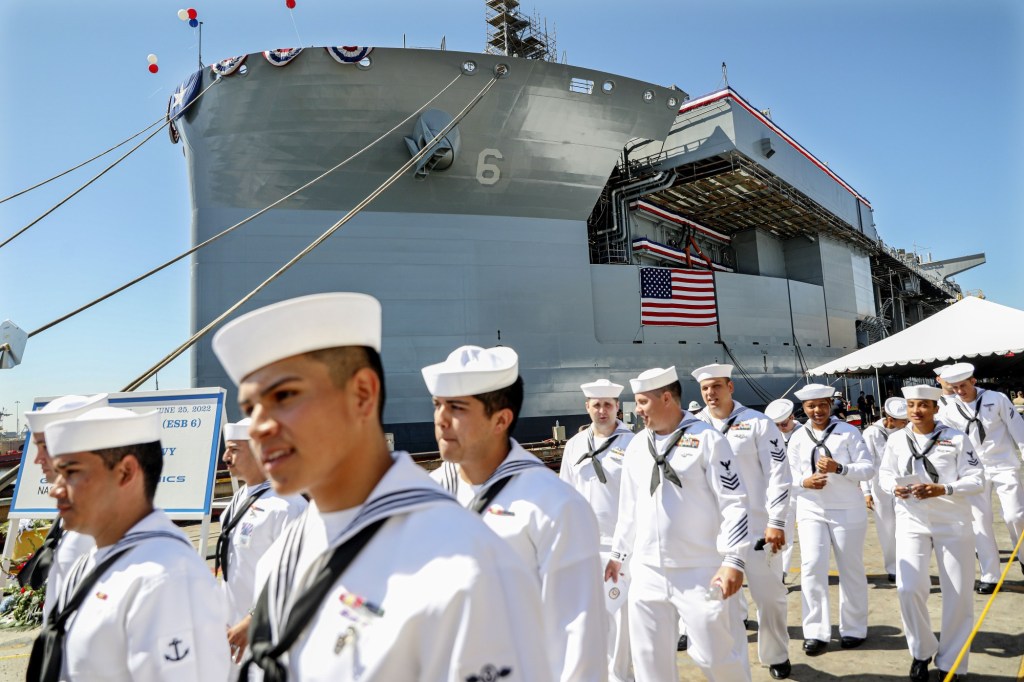

The U.S. Navy — which is struggling to build badly needed warships and submarines and develop weapons powerful enough to keep China in check — might soon be run by a businessman-investor with no military experience.
President-elect Donald Trump has nominated John Phelan to become the next secretary of the Navy, making him responsible for roughly 900,000 sailors, Marines, reservists and civilian personnel.
The U.S. hasn’t had a Navy secretary with no military experience — either in uniform or as a defense civilian — since 2006, when Donald Winter began a three-year tenure.
Phelan, 60, is in line to replace Secretary Carlos Del Toro, who has been a frequent visitor to San Diego, the headquarters of the Navy’s Third Fleet. The city is home to 56 surface warships and four fast-attack submarines.
Phelan is the co-founder of Rugger Management, a private investment firm based in Florida, and a major Republican donor, giving nearly $1 million to GOP committees and candidates in 2024 alone, campaign finance records show.
Experts told The Associated Press that Phelan’s nomination reflects that Trump is seeking service branch heads who will not push back on his ideas — but that his lack of experience is likely to create issues of its own.
“It will be difficult for anyone without experience in the Pentagon to take over the leadership of a service and do a good job,” said Stacie Pettyjohn, a senior fellow and director of the defense program at the Center for a New American Security. “Services are sprawling organizations with distinct cultures, subcultures and bureaucratic interests, and where decisions are made through many formal processes. To change a service’s plans, one must understand this byzantine landscape.”
Phelan will face a daunting task leading the Navy if he becomes secretary. The service’s problems are deep and widespread.
“The Navy is stretched covering Europe, the Middle East and the Pacific. Strategists have wanted to pull back from Europe and the Middle East, but recent conflicts have prevented that,” said Mark Cancian, a senior adviser at the Center for Strategic and International Studies. “So the next secretary will have a shrinking fleet, expanded overseas commitments, and an uncertain budget environment.”
Just over a decade ago, the Navy had about 55 surface warships in San Diego, a number that was projected to rise to 70 by now. Under a plan called the Pacific Pivot, the Navy intended to reposition a lot of ships to San Diego to give it faster, more direct access to the Indo-Pacific, where tensions with China were starting to rise.
The change did not come to pass. The number of Navy ships fleet-wide has been dropping at the same time the number of Chinese warships has been rising.
The problem has largely been caused by huge cost overruns, design issues and construction delays in the Navy’s shipbuilding program, according to the U.S. Government Accountability Office.
Earlier this month, the backlog led the Navy to extend the service life of 15 older destroyers and cruisers, including four that are homeported in San Diego.
The Navy also is struggling because the littoral combat ships it introduced more than a decade ago to replace aging frigates have proven to be of limited use, and they don’t have sufficient weapons to defend themselves, the GAO has reported. San Diego is home to more than a dozen such ships.
A new generation of frigates is supposed to replace the littoral combat ships, but it’s unclear when they will go into service in San Diego and at other key bases. The first Constellation-class frigate was supposed to be delivered in April. The date has been pushed back at least three years due to construction delays and design issues.
The delays come at a time when the Navy is trying to deepen its ties to allies. Earlier this fall, American F-35B pilots spent weeks conducting test landings and takeoffs on a Japanese aircraft carrier operating off San Diego. The pilots were making sure that the jets are compatible with the carrier. Japan has ordered dozens of the aircraft to defend itself — and possibly to help the U.S. repel China if it invades Taiwan.
One of the Navy’s biggest challenges is preparing for a potential military confrontation with China over Taiwan.
“The stakes are high,” said Brad Bowman, senior director of the Center on Military and Political Power at the Foundation for Defense of Democracies. “The success or failure in addressing key problems in the U.S. Navy over the next couple years may have a decisive effect on war and peace in the Taiwan Strait and elsewhere.”
Service branch chiefs spend vast amounts of time not only responding to the White House but also appeasing local members of Congress in frequent hearings on Capitol Hill, shaping budget requests, holding constant meetings on service member issues, attending industry conferences and filling speakers requests.
That all requires a nuanced understanding of the service that a secretary is leading, because major change in any of the branches often involves a lengthy process to review directives and past policy. Any changes to the many weapons systems the Navy and Marine Corps need and pursue are subject to lengthy contract award challenges.
“It might help that he has a personal relationship with the president. However, his lack of experience in defense and the Pentagon will hurt the Navy,” Cancian said. “It will take him a while to learn the levers of power.”
The Associated Press contributed to this report.





